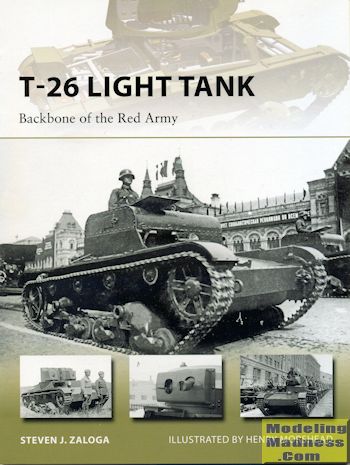 One of
the more prominent tanks of the 1930s was the Soviet T-26 light tank. This tank
was built according to the needs of the time and at the time it was felt that a
lot of tanks would be a good thing. This was championed in the Soviet army by
some influential generals who had seen how well the French and British tanks had
performed in the later days of WWII when mobile warfare had returned to the
battlefield.
One of
the more prominent tanks of the 1930s was the Soviet T-26 light tank. This tank
was built according to the needs of the time and at the time it was felt that a
lot of tanks would be a good thing. This was championed in the Soviet army by
some influential generals who had seen how well the French and British tanks had
performed in the later days of WWII when mobile warfare had returned to the
battlefield.
Several designs were put forth and what eventually became the T-26 was
chosen. The tank was produced in a single turret version and a twin turret tank.
The twin turrets could either have two machine guns or one maching gun and one
cannon. The canon chosen was a Soviet copy of the French Hotchkiss 37mm version.
In fact, the T-26 itself was little more than a Soviet adaptation of the British
Vickers tank, a tank that the British army had found to be wanting and never
used, but approved for export.
As you would expect from a Soviet tank during this time, it was rife
with issues. It was underpowered, hand an engine that required overhaul rather
frequently (as in less than 500 miles of use), poor clutch assemblies, a
cramped, unergonomic interior and poor ventilation that caused near asphyxiation
of the crew after firing several rounds from its cannon. It also had a very poor
radio and an easily damaged hoop antenna array. Add to that rather thin armor
that anything other than a small calibre rifle bullet could penetrate, and you
had a tank that needed some major upgrades.
Some of these situations were taken care of, including some appliqué
armor, better interior ventilation, a slightly more powerful engine and later a
somewhat better radio. However, the type was never destined to do well and a
quite large percentage of the tanks lost by the Soviets during the first year of
the war as well as their wars with Finland were T-26s.
The type was developed into other armored vehicles, one of the most
successful was the flame thrower tank. This despite its rather short firing
distance. It was also developed into a SPG, an ammo carrier and a prime mover
for light artillery pieces. Regardless of its poor performance, it was used
throughout the war and particularly in Manchuria where it was used against the
Japanese when the Russians entered the war in the Pacific after the first atomic
bomb had been dropped.
Author Steven Zaloga looks at the origins of the T-26, its development,
the different variants of the tank and its deployment in combat. This includes
its operations during the Spanish Civil War where it was (typically) mis-used
and rather than combined with infantry attacks, was used piece-meal as a morale
booster as anything else. This was to set a pattern that was quite typical of
Soviet tank tactics, particularly since most of the really knowledgeable leaders
had been purged during Stalin's mass paranoia of the late 1930s. Add to all this
the excellent period photos and the art work of Henry Morshead, and you have a
great little reference book for your shelves.
April 2015
For more on the complete line of Osprey books,
visit http://ospreygrp.com. In the US, it is
Osprey Direct at 44-02 23rd St, Suite 219, Long Island City, NY 11101., where you can
get a catalogue of available books.
If you would like your product reviewed fairly and
fairly quickly, please
contact
the editor or see other details in the
Note to
Contributors.
 One of
the more prominent tanks of the 1930s was the Soviet T-26 light tank. This tank
was built according to the needs of the time and at the time it was felt that a
lot of tanks would be a good thing. This was championed in the Soviet army by
some influential generals who had seen how well the French and British tanks had
performed in the later days of WWII when mobile warfare had returned to the
battlefield.
One of
the more prominent tanks of the 1930s was the Soviet T-26 light tank. This tank
was built according to the needs of the time and at the time it was felt that a
lot of tanks would be a good thing. This was championed in the Soviet army by
some influential generals who had seen how well the French and British tanks had
performed in the later days of WWII when mobile warfare had returned to the
battlefield.